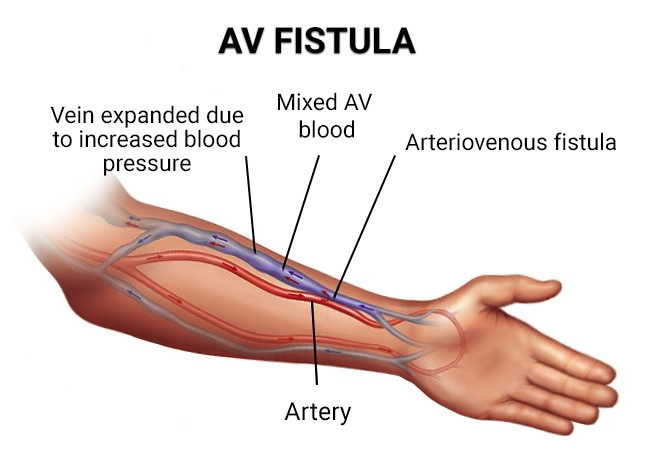
Fistula Dialysis
Consultation
Fistula for Dialysis

Key Aspects of AV Fistula for Dialysis
Creation Procedure
Surgeons create an AV fistula by connecting an artery and a nearby vein. This connection causes increased blood flow and pressure in the vein, making it more suitable for repeated needle insertions during dialysis.kin.
Preferred Vascular Access
AV fistulas are considered the gold standard for vascular access in hemodialysis. They are preferred over other access types, such as arteriovenous grafts or central venous catheters, due to their longevity and lower infection rates.
Maturation Period
After the creation of an AV fistula, there is a maturation period during which the vein enlarges and strengthens to accommodate the increased blood flow required for dialysis. This process typically takes a few weeks to a few months.
Needle Insertion for Dialysis
Once matured, the AV fistula becomes the site for needle insertion during hemodialysis. The two needles—one to draw blood from the body to the dialysis machine (arterial needle) and one to return filtered blood to the body (venous needle)—are inserted into the AV fistula.
Long-Term Durability
AV fistulas are known for their durability and ability to provide reliable vascular access for an extended period. Their longevity is crucial for individuals requiring frequent hemodialysis sessions.
Reduced Infection Risk
Compared to other types of vascular access, AV fistulas have a lower risk of infection. This is an important consideration given the increased susceptibility of individuals on hemodialysis to infections.
Regular Monitoring
Individuals with AV fistulas undergo regular monitoring to ensure their proper function. This includes checking blood flow, assessing for any signs of infection, and evaluating the overall health of the access site.
Prevention of Complications
Proper care and maintenance of the AV fistula, including avoiding trauma to the access arm and ensuring adequate blood flow, are essential to prevent complications such as stenosis or thrombosis.
Patient Education
Individuals with AV fistulas receive education on self-care, recognizing signs of complications, and maintaining overall vascular health. This empowers them to actively participate in the care of their access site.
Post-op Care
- A fistula can take up to six weeks to be mature ready for haemodialysis.
- Exercising your arm in which the fistula is created will help the fistula to develop faster• Take a sponge ball and place the ball in the hand with the fistula.
- Squeeze the ball repeatedly for five to 10 minutes. Try and repeat this two to three times a day.
- If your arm becomes tired or painful during the exercises stop and rest your arm.
- Do not let anyone start an IV line or draw blood from AVF arm.
- Do not let anyone take blood pressure from AVF arm.
- Do not sleep on AVF arm.
- Do not carry heavy weights with AVF arm (no more than 2 kg).
- Do not wear a watch, bracelet or tight clothes over AV fistula.
- Do not allow straps or handles tighten around the fistula, it is best to avoid carrying a purse or bag on that arm.

